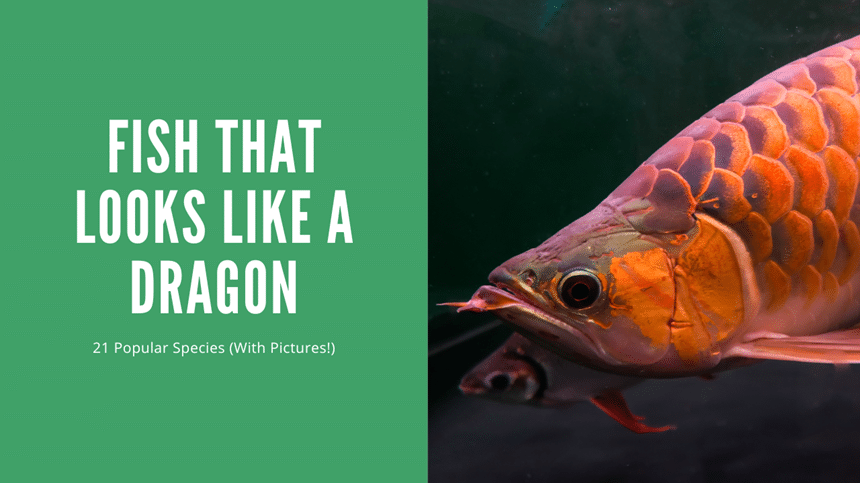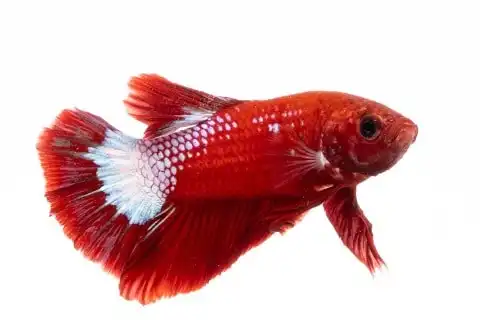Thank you for visiting! By the way… any links on this page that lead to products on Amazon and other stores/partners are affiliate links Aquarium Store Depot earns a commission if you make a purchase.
Some fish are colorful, some fish are cute, and some fish look like dragons! In this post, we’ll be introducing 21 weird and wonderful fish, from little dragons just an inch or two long to massive sea monsters as long as a school bus!
Read along to learn about some great fresh and saltwater dragon fish that you can keep in an aquarium, and some that are better left out in their natural habitat.
Let’s get into it!
Key Takeaways
- Many fish species have sharp teeth, spiny fins, and beard-like growths that make them look just like dragons.
- Some popular aquarium fish like bettas and guppies have been selectively bred to look more like dragon fish, but their care is much the same as other breeds.
- Most of the species in this post are available in the aquarium hobby, so you can keep your very own dragon fish at home.
- Some dragon fish, like the deep sea angler fish and giant oarfish, live in very specialized habitats or grow very large, so you won’t find them at your local fish store
Fish That Looks Like A Dragon – 21 Species
Are you ready to meet 21 amazing dragon fish? This list includes freshwater species like the prehistoric bichirs, brackish fish like the eel gobies, and saltwater species like the leafy seadragon.
Many of these fish can be kept in a home aquarium, but some of them are better left to the experts. So, if you are looking for your very own dragon fish pet, be sure to check out the suggested temperatures, tank sizes, and care levels for each species to help you choose the right species.
Let’s get started!
1. Arowana
- Scientific Name: Osteoglossum and Scleropages spp.
- Difficulty Level: Advanced
- Temperament: Aggressive
- Adult Size: Up to 4 feet
- Minimum Tank Size: 250 gallons +
- Diet: Carnivore, eats insects and small fish
- Origin: Australia, Asia, and South America
- Temperature: 75 – 82 °F
Arowanas are amazing freshwater fish with dragon-like scales and a huge mouth. In fact, the endangered Asian Arowana (Scleropages formosus) is even known as the ‘dragon fish’ due to its unique appearance.
There are several species of these large freshwater fish distributed from South America to Australia, and they can make impressive pets. However, these monster fish need a very large tank and the experience of a dedicated fishkeeper for long-term care.
2. Axolotl

- Scientific Name: Ambystoma mexicanum
- Difficulty Level: Moderate
- Temperament: Peaceful
- Adult Size: Usually 9-12 inches
- Minimum Tank Size: 20 gallons +
- Diet: Carnivore, eats invertebrates and small fish
- Origin: Mexico
- Temperature: 59 – 73 °F
The axolotl is a bizarre-looking critter that makes a wonderful aquarium pet. These dragon-like amphibians are not true fish, although they spend their entire lives under the water!
Axolotls are critically endangered in the wild due to the destruction of their native habitat in Mexico, but fortunately, these interesting animals are still common in captivity. They require cool water conditions and a healthy diet of live or frozen foods like brine shrimp and earthworms.
3. Bettas
Use Coupon Code ASDFISH at Checkout
Betta Fish are one of the most beautiful varieties of freshwater fish available in the hobby. Easy to care for with plenty of varieties!
- Scientific Name: Betta splendens
- Difficulty Level: Beginner
- Temperament: Aggressive
- Adult Size: 2.5 inches
- Minimum Tank Size: 5 gallons +
- Diet: Carnivore
- Origin: Southeast Asia
- Temperature: 76 – 81°F
Bettas, or Siamese fighting fish, are popular all over the world for their beauty and feisty personalities. These small fresh water fish make great pets, especially for fishkeepers who don’t have room for a big tank.
All bettas have a dramatic appearance, with bright colors and large flowing fins, but one breed stands out for its dragon-like appearance. Dragon scale bettas have extra large, metallic scales. Their body color is usually pearly white, and many specimens have fiery red fins.
Betta fish are easy to care for if you provide a tank of at least 5 gallons, complete with a filter and heater. Avoid overfeeding and test your water regularly to monitor nitrate, nitrite, and ammonia levels to prevent common illnesses like fin rot or ich.
4. Purple Dragon Guppy
- Scientific Name: Poecilia reticulata
- Difficulty Level: Beginner
- Temperament: Peaceful
- Adult Size: Up to 2.5 inches
- Minimum Tank Size: 10 gallons
- Diet: Omnivore
- Origin: South America
- Temperature: 72 – 82 °F
Guppies are another world-famous fish that are sometimes associated with dragons. The purple dragon guppy is an awesome fancy guppy breed, with eye-catching colors and patterns. Males are smaller and more boldly marked, but even female dragon guppies have great patterning on their tails and dorsal fins.
They may be a fancy breed, but purple dragon guppies are very easy to care for. These fun tropical fish are very easy to breed in a freshwater aquarium, which is a great hobby for everyone from beginners to advanced aquarists!
5. Dragon Eye Goldfish

- Scientific Name: Carassius auratus
- Difficulty Level: Moderate
- Temperament: Peaceful
- Adult Size: Up to 8 inches
- Minimum Tank Size: 20 gallons +
- Diet: Omnivorous, feeds on invertebrates and plants
- Origin: China
- Temperature: 65 – 72 °F
Dragon eye goldfish are a strange but beautiful goldfish breed with bulging telescope eyes. These fancy goldfish have ancient origins in China, where the breed was first developed over 300 years ago!
The popular black moor goldfish is a variation of the dragon eye that is popular all over the world, and readily available online or from aquarium stores. These adorable fish should be kept in a large aquarium with cool water and a gentle current. With good care, they can live for over 20 years.
6. Senegal Bichir

- Scientific Name: Polypterus senegalus
- Difficulty Level: Moderate
- Temperament: Semi-aggressive
- Adult Size: Up to 20 inches
- Minimum Tank Size: 55 gallons +
- Diet: Carnivore
- Origin: Africa
- Temperature: 75 – 82 °F
The Senegal bichir is a prehistoric-looking fish from Africa, that is often called the dragon fish. These fish look almost like a cross between a dinosaur and an eel, so they make a really cool display animal for a big enough fish tank.
Despite their strange looks, these fish are not particularly aggressive, although they will swallow any small fish that swims in reach of their large mouths! Large and medium-sized fish with peaceful personalities make the best tank mates for these interesting fish.
These strange creatures are one of the few fish that can breathe air from the surface and can even walk across land. Check out my guide to 15 fish with legs to learn much more about walking fish!
7. Dragonface Pipefish

- Scientific Name: Corythoichthys sp.
- Difficulty Level: Advanced
- Temperament: Peaceful
- Adult Size: 7 inches
- Minimum Tank Size: 55 gallons
- Diet: Copepods
- Origin: Pacific Ocean
- Temperature: 72 – 78 °F
- Reef Safe: Yes
- Available As Tank Bred: No
The Dragonface pipefish is a unique, eel-like fish from the seahorse family that hangs out on the floor of tropical reefs, waiting for small copepods to snack on. These unique fish have very dragon-like faces, complete with big eyes and a long snout.
Dragonface pipe fish are popular in the reef aquarium hobby, although they have a specialized diet and are difficult to maintain if you don’t have a steady supply of live copepods to feed them. These tiny crustaceans are available from specialist aquarium stores, but you still need to make sure the other fish don’t eat all the food!
8. Dragon Goby/ Violet Goby
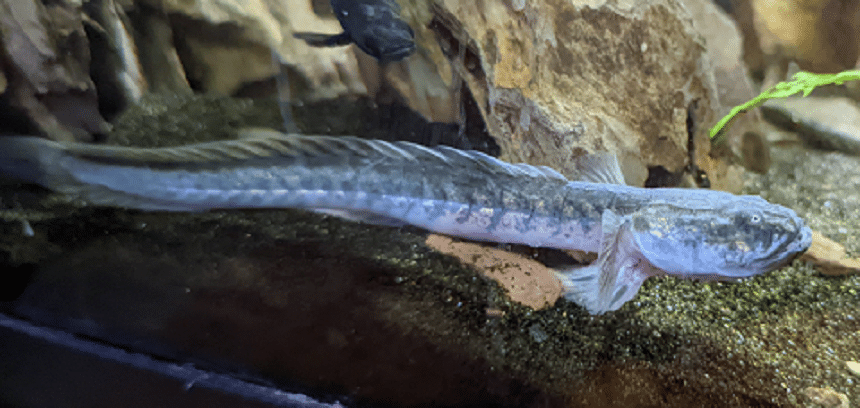
- Scientific Name: Gobioides broussonetii
- Difficulty Level: Moderate
- Temperament: Peaceful but territorial with their own kind
- Adult Size: Can reach over 15 inches
- Minimum Tank Size: 55 gallons +
- Diet: Filter-feeder
- Origin: Southern USA to South and Central America
- Temperature: 73 – 78 °F
- Reef Safe: Brackish water fish, not recommended for reef tanks
- Available As Tank Bred: No
The dragon goby is a mean-looking fish with upward-facing eyes, a strong jaw, and a row of spiky fins along its back, just like a dragon. Also known as violet gobies, these bottom dwellers are most at home in brackish waters, although they are sometimes found in fresh and saltwater habitats.
Dragon gobies can be kept in brackish water aquariums, although they prefer a thick layer of soft sand to burrow in and they are not the most exciting pets. They look very similar to Peruvian gobies and are often sold under the same name. Both of these eel gobies may look aggressive, but they actually eat algae and other small food particles, so they are safe to keep with smaller fish.
9. Dragon Moray Eel

- Scientific Name: Enchelycore pardalis
- Difficulty Level: Advanced
- Temperament: Aggressive
- Adult Size: Up to 3 feet
- Minimum Tank Size: 150 – 200 gallons
- Diet: Carnivore, eats other fish and sea creatures
- Origin: Indo-Pacific Ocean
- Temperature: 72 – 78 °F
- Reef Safe: Does not eat corals, but will eat smaller fish
- Available As Tank Bred: No
The dragon moray is a colorful tropical reef creature that looks like a dragon. These snake-like fish manage to look beautiful and scary at the same time, making them an awesome choice for a large tropical marine aquarium. However, keep in mind they are difficult to keep. You could opt for a standard moray eel which are more hardy, though aggressive.
10. Seadragons

- Scientific Name: Phycodurus & Phyllopteryx spp.
- Diet: Carnivore, eats small marine invertebrates
- Size: 9 – 18 inches
- Origin: Southern Australia
- Available in the hobby: Very rare
Seadragons are unique and delicate saltwater fish from the seahorse family. The leafy seadragon is a true master of camouflage that looks just like a drifting clump of seaweed as it forages near the sea floor. Weedy sea dragons are more colorful creatures with interesting paddle-shaped fins. Despite their different body shapes, each species has an undeniably dragon-like face!
Sea dragons are usually only kept in large public aquariums because they are rare and require specialized care.
11. Lionfish
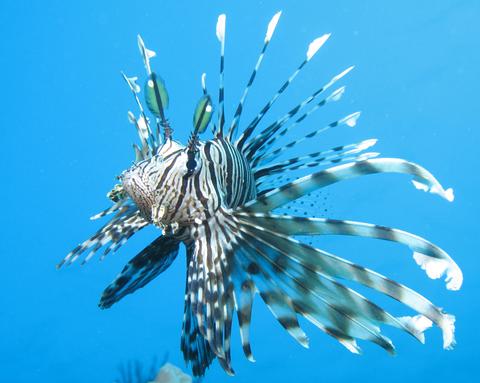
- Scientific Name: Pterois spp.
- Difficulty Level: Moderate
- Temperament: Semi-aggressive
- Adult Size: Up to 18 inches
- Minimum Tank Size: 30 – 125 gallons, depending on the species
- Diet: Carnivore
- Origin: Tropical regions of the Atlantic, Pacific, and Indian Oceans
- Temperature: 72 – 78 °F
- Reef Safe: Possible, but will consume smaller fish and invertebrates
- Available As Tank Bred: No
There are several similar species of lionfish distributed in tropical waters across the globe, each with beard-like growths and huge spiky fins like a dragon’s wings.
These striking fish are usually red and white in color and are also known as firefish. Lionfish are popular aquarium pets, although they are venomous, so they should never be handled.
12. Pacific Blackdragon
- Scientific Name: Idiacanthus antrostomus
- Diet: Carnivore
- Size: 2 feet
- Origin: West Coast of North America
- Available in the hobby: No
The Pacific Black Dragon is a deepsea fish that lives several thousand feet below the surface in the cold, dark waters of the Eastern Pacific. These sea monsters have a mouth full of sharp fangs and a beard-like growth under their jaws that gives them a real dragon-like look!
13. Blue Sea Dragon

- Scientific Name: Glaucus atlanticus
- Diet: Carnivore that feeds on jellyfish and other venomous sea creatures
- Size: about 1 inch
- Origin: Recorded off Africa, Europe, Asia, Australia, North and South America
- Available in the hobby: No
The blue sea dragon is a stunning sea animal that lives at the surface of the ocean in many parts of the world. These bright blue creatures are not actually fish but rather a type of carnivorous mollusk.
Unfortunately, these sea slugs cannot be kept in a home aquarium, but they are sometimes found washed up on beaches. If you do spot a blue sea dragon, don’t be tempted to touch it; these animals give a painful sting!
14. Dragonets
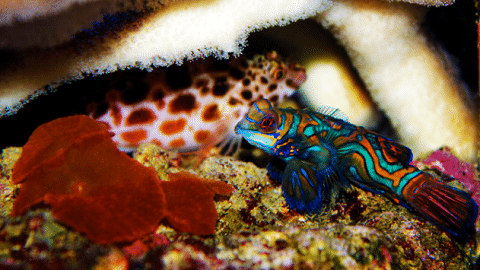
- Scientific Name: Synchiropus spp.
- Difficulty Level: Advanced
- Temperament: Peaceful
- Adult Size: usually about 3 inches, but some species grow up to 12 inches
- Minimum Tank Size: 30 gallons
- Diet: Carnivorous, feeds on copepods and other live invertebrates
- Origin: Indo-pacific
- Temperature: 72 – 78 °F
- Reef Safe: Yes
- Available As Tank Bred: Yes
Dragonets are small tropical reef fish with dazzling colors. Several species of these goby-like fish are available in the hobby, although they are best left to experienced and dedicated reef keepers who can provide a steady supply of live copepods.
15. Giant Oarfish
- Scientific Name: Regalecus glesne
- Diet: Carnivorous filter feeder
- Size: Can exceed 30 feet!
- Origin: Worldwide in temperate and tropical oceans
- Available in the hobby: No
The giant oarfish is the world’s longest fish and a true sea monster of the deep. These serpent-like fish have a spiky red crest and long tassel-like fins below their heads that make them look just like a dragon!
Despite their fearsome appearance, giant oarfish are not aggressive fish and actually feed on tiny sea creatures that they filter out of the water.
16. Deep Sea Anglerfish
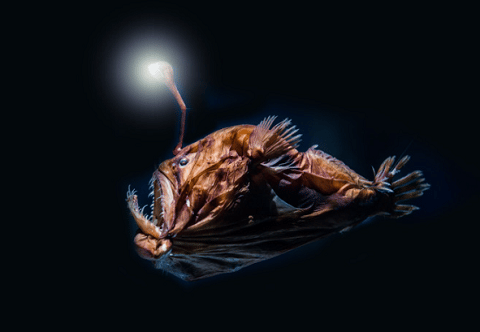
- Scientific Name: Melanocetus johnsonii etc.
- Diet: Carnivores
- Size: 1 – 6 inches
- Origin: Widespread in tropical and temperate oceans
- Available in the hobby: No
The humpback anglerfish is a terrifying deep-sea fish that looks like something straight out of a nightmare. These fascinating creatures grow to about 6 inches, so they’re actually just miniature monsters from the deep.
The deepsea anglerfish has impressive fangs and a huge mouth for capturing small fish and other unfortunate sea creatures. They may not breathe fire, but these deepsea dragon fish do have a glowing lure on the end of a stalk that attracts their prey within striking distance.
17. Seahorses

- Scientific Name: Hippocampus spp.
- Difficulty Level: Advanced
- Temperament: Peaceful
- Adult Size: Up to 13 inches depending on the species
- Minimum Tank Size: 30 gallons for smaller species
- Diet: Carnivorous, eats live crustaceans
- Origin: Widespread in warm, shallow coastal areas
- Temperature: 72-78 °F
- Reef Safe: Yes
- Available As Tank Bred: Yes
Seahorses may be named after common farm animals, but if you look a little closer, these adorable creatures have a striking resemblance to miniature dragons! These little fish from the Syngnathidae family have spiky, elongated bodies, spiny crests, and long snouts that make them look nothing like a regular fish.
Seahorses are small and peaceful creatures that inhabit shallow coastal waters around the world where they hunt tiny crustaceans. They are slow swimmers that prefer to grasp onto seaweed and other structures with their prehensile tails than fight against strong sea currents.
Several captive-bred seahorse species are available in the aquarium hobby, and they make fascinating display animals for dedicated fishkeepers. Avoid wild-caught specimens because they are difficult to keep without live food.
18. Stoplight Loosejaw
- Scientific Name: Malacosteus sp.
- Diet: Carnivore, feeds on marine invertebrates and other fish
- Size: Reaches 10 inches
- Origin: Worldwide in deep oceans
- Available in the hobby: No
Stoplight loosejaws are deep-sea-dwellers that live thousands of feet below the surface in total darkness. They have evolved the incredible ability to produce green and red light from special organs in their jaw, which they can use to find their prey in the darkness.
These scary dragon fish have tiny tails, long, sharp teeth, and huge jaws. However, they only live below about 1,500 feet and grow to less than a foot long, so you have nothing to fear next time you visit the beach!
19. Teugelsi Bichir
- Scientific Name: Polypterus teugelsi
- Difficulty Level: Moderate
- Temperament: Semi-aggressive
- Adult Size: Up to 25 inches
- Minimum Tank Size: 150 gallons for full-grown specimens
- Diet: Carnivorous, feeds on invertebrates and other fish
- Origin: West Africa
- Temperature: 77-82 °F
The Teugelsi bichir is a rare but fascinating freshwater fish that looks like a dragon. These prehistoric forest-dwellers have prominent scales and a spiky dorsal fin just like a mythical fire-breathing monster!
The species is occasionally seen for sale in the aquarium trade and makes an interesting pet for fishkeepers with large tanks. Like other bichirs, these fish are carnivorous and will snack on other fish at night when they come out to feed.
20. Mottled Bichir
- Scientific Name: Polypterus weeksii
- Difficulty Level: Moderate
- Temperament: Semi-aggressive
- Adult Size: Grows to about 23 inches
- Minimum Tank Size: 150 gallons for a full-grown specimen
- Diet: Carnivore
- Origin: Central Africa
- Temperature: 76 – 82 °F
Here’s another freshwater dragon fish for all the bichir lovers out there. The mottled bichir is a fascinating predatory species from Africa with an intimidating scaly appearance.
These rare nocturnal fish need a high-protein diet to stay healthy, so they are not recommended for a community aquarium with smaller tank mates! They are very hardy fish that can breathe air and even travel over land in moist conditions.
21. Scorpionfish
- Scientific Name: Scorpaenidae family
- Difficulty Level: Moderate
- Temperament: Semi-aggressive
- Adult Size: 2 inches to 3 feet
- Minimum Tank Size: 30 gallons + depending on species
- Diet: Carnivorous, feeds on other fish and small sea creatures
- Origin: Widespread in marine and brackish habitats
- Temperature: Species dependent
- Reef Safe: With caution
- Available As Tank Bred: No
Scorpionfish are a large group of bizarre saltwater fish with dragon-like features and a venomous spine. These carnivorous fish often have amazing camouflage, which they rely on to ambush their prey. Many species are available for marine aquariums, but be warned, some of these fish are very dangerous!
22. Koi

- Scientific Name: Cyprinus carpio
- Difficulty Level: Moderate
- Temperament: Peaceful
- Adult Size: Over 2 feet
- Minimum Tank Size: 1500 gallons
- Diet: Omnivorous
- Origin: Indonesia
- Temperature: 59 – 77 °F
The famous Koi fish is seen as a noble creature in Japan. There is a legend that states that if a Koi climbed the waterfall on the Yellow River that it would turn into a Koi Dragon.
The most similar looking Koi to be found in the hobby that looks like a dragon would be a butterfly koi. Though not considered a true koi by many purist, their fins give them that flying look.
Final Thoughts
Dragons do exist! Maybe not the flying, firebreathing kind you’ve seen in the movies, but there’s plenty of weird and wonderful dragon fish swimming around out there. Some of these amazing animals even thrive in fish tanks, so who knows, you could even keep a dragon in your own room.
Which fish do you think most resembles a real-life dragon? Share your top pick in the comments below!
- About the Author
- Latest Posts
I’m thrilled that you found Aquarium Store Depot! Here you’ll find information on fish, aquariums, and all things aquatics related. I’m a hobbyist (being doing this since I was 11) and here to help other hobbyists thrive with their aquariums! I adhere to a high quality Editorial Process and Review products with real life field usage and practical analysis.

